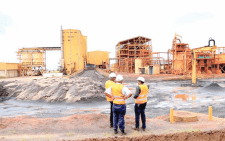Hotelier finds respite in greenhouse farming

Harriet James @harriet86jim
For more than two decades, greenhouse commercial horticulture in Kenya has evolved to be a significant sector in the economy.
By definition, greenhouse farming comprises growing horticulture, such as fruits, flowers, as well as vegetables in a framed or inflated structure covered with a transparent or translucent material under controlled climatic conditions at a partially controlled environment.
A net like material is used on the side for air ventilation. The popularity of this farming method can be attributed to the reliance on agriculture as a serious investment for those who want to mint cash.
Most farmers who have ventured into it and deal with horticultural products, such as onions, tomatoes and even capsicum, have claimed to have great gains with this venture.
For instance, John Musau, the general manager of Tamarind Tree Hotel, who also doubles up as a greenhouse farmer attests to this success ever since he began farming 10 years ago.
A t his farm in Kiserian, Kajiado county, he has six green houses measuring eight metres by 30 metres where he plants onions and tomatoes for both commercial and local consumption.
“There is a lot of demand for food at this time and some people just come to the farm just to have tomatoes to eat and others to sell.
There is also demand in supermarkets and hotels, but the main one is the local market,” he says.
Area greenhouse legislation
It is this farming that has kept him busy especially during the pandemic when jobs are low and the tourism sector experiencing such turmoil.

Musau recalls how labour-intensive and costly it was to start the green house at the beginning.
He first conducted a research on the local market to know which kind of crops would do well and what the soil in the area would be suitable for.
He then had to learn the legislation of the land with regards to greenhouses and also the best greenhouse design that would be both cost effective and bring much yields.
“I built the first greenhouse from scratch and in the first year of farming, it gave me Sh500,000. This is what I used to invest in other greenhouses,” he says.
One of the advantages of having a green house is increased production, Musau says. It is deemed to be an implementation of intensive agriculture.
“This is because you have more control over regulating the temperature required for plant growth and are able to grow more plants per square feet compared to growing crops in an open field,” says Musau.
He adds that there is minimised production risks as being in an enclosed space can assist in safeguarding the crops from climate change related events, such as drop in temperature or even sudden increases and also keeping crops away from birds and other animals. Another advantage is maximising profits.
Numerous studies have indicated that the profits per crop per square feet can be even twice or thrice as much when implementing greenhouse farming compared to open field agriculture. Resources are utilised in a more efficient manner, which minimises waste and this results in more profits.
Uses bio-fertiliser or manure
There is also increased pests, weeds and even disease control. “Tomatoes are a very delicate crop, I regulate people who step in the greenhouse because hygiene is very important.
We sanitise our feet before we get in. If your worker is dirty or has picked up pests in his clothes from somewhere else, that contaminateds your greenhouse,” says Musau.
In addition, he uses bio fertiliser or goat manure instead of chemicals in his bid to go as green as possible when taking care of his farm.
When it comes to pest control, he uses traps, such as white fly traps and from time to time he uses pesticides. To ensure high yields, Musau also practices crop rotation.
A well designed greenhouse can prevent weeds and pests and also gives more control against other diseases.
Another advantage is the ability to grow year-round produce, even off-season.
However, the venture comes with its fair share of cons. For instance, the operational costs of greenhouse farming are generally higher than those of open field agriculture.
It is also not easy to maintain adequate conditions for plant growth inside the greenhouse, and that means spending money on electricity and even water.
One also requires highly skilled personnel to handle the farm. “One requires people who understand the variables of the environment and are also alert so that if any issue arises, it can be fixed immediately,” he says.
To solve that, he goes to his farm every weekend to check on what’s going on. Another con is that one must have a steady supply of water.












